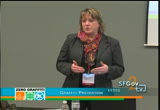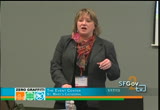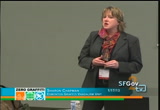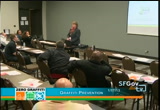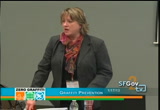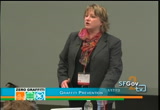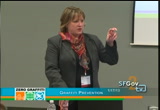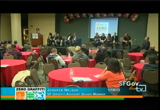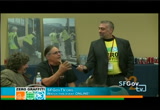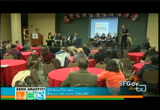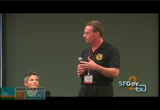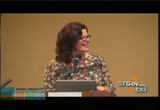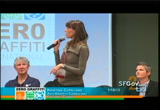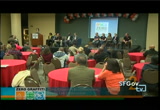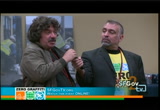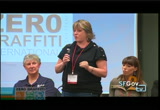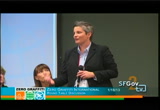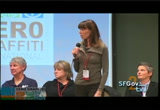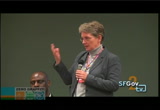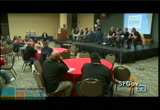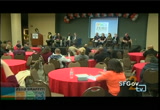tv [untitled] April 20, 2013 4:14pm-4:44pm PDT
4:14 pm
and great, you are getting rid of the graffiti and in 6 months it's completely different. >> you are going to monitor the area for two years? >> yes, for two years, then we'll do post-audit. i'm hoping to be able to do two audits on this area as opposed to one year. how are we doing for time? any other questions? >> i might have missed this in the beginning, but i was curious, how do you guys get funded for this program. >> capital city clean up is a city of edmonton program. it started in 2005 as a litter reduction program and when our bylaw changed in 2008 our city council was very thoughtful in determining they needed to put their mouths were. basically they were going to require the property owners clean their graffiti, then they needed to put some effort into cleaning their own graffiti as well as
4:15 pm
supporting property owners in those efforts. >> so you have steady funding? >> yes, i have steady funding for the audit and the clean up program. >> how often do you share your data with other departments? >> always. mark and i just finished finalizing it last week, but we will be holding a press conference basically when i get back, so we will be sharing the information with all the city departments as well as the city in general and going through that. we're very open about the results. the only information that we don't publish is we don't publish the tagger names. if you were in our other presentation, we're very careful about not giving them air time. we don't want
4:16 pm
brute knowing he's the most prolific tagger in the city. that's not to my benefit, only to his. but we will say, for example, of the top 10 taggers one has been arrested. we will make that information known in a generic way during our press conferences. >> what type of material are you using for the panels. >> the panels? >> yeah. >> we haven't determined yet what we're going to use for the panels. it will really depend what structure we end up looking it on. we're looking at 4 locations for the free wall at this time. again, everything that i've seen shows that they don't work. we're kind of caught between a rock and a hard place on this in that the public art plan was approved by city council that includes the creation of free walls so we figure better to control it as opposed to fight it because we weren't going to win the fight. again, by taking this approach we think we'll have some really good
4:17 pm
empirical data at the end of it to say, look, this is how much graffiti in that neighborhood increased over the last two years. this is how much additional graffiti was on each of those streets. this is how angry the property owners are now compared to what they were then and these are the physical changes. we'll be looking at, again, safety and security issues as well as we go through that project. any other questions? >> i just have one more. i was curious if you guys take into account any other sort of statistics, say, like the neighborhood of which area is getting tagged, do you take into account the demographics in the sense of ethnicity or their economy of, you know, which type of --. >> we haven't to date, but we haven't really done that type of analysis. i think that's something we'd like to look at in the future in terms of
4:18 pm
getting down into the types of tagging. the graffiti i think it would be fair to say that the neighborhoods that have the highest incidents of graffiti tend to follow along where those business revitalization loans are or in areas of lower economic income, but we haven't done anything about ethnicity -- what you said. but we are actually looking at it. my director who just started with our branch last year is doing her master's in the area actually so that's something she wants to look at in the next few years. >> just wondering how long does it take to do an audit for a 4 by 4 block radius. >> it depends on how much graffiti they find, but the audit generally takes about 10 days. >> 20 to 25 neighborhoods, we
4:19 pm
can do about 2 1/2 neighborhoods a day. >> say that again? >> two neighborhoods, 2 1/2 neighborhoods a day. you are literally 4 blocks by 4 blocks doesn't sound very big. you are doing every alleyway, behind every house, so if there's a lot of graffiti there it's pretty slow going. >> other questions? >> you have a lot of different components to your program. my question would be what are your performance measures? >> this is one of our performance measures, the results of the audit. we also do a survey on an annual basis of every property owner who does a, receives a notification to remove graffiti off of their property. so we do independent
4:20 pm
survey with them. we have about a 10 percent compliance rate on our survey, which is quite good statistically, given the number of surveys we send out, so we are able to analyze the response by the community. we also do an omnibus survey, we tag on to another existing survey to determine what the community response is how they feel edmonton is doing, we've seen really positive results to that in terms of people feeling that the amount of graffiti is going down within edmonton. i have individual program surveys that i do with all our programs. for example, the professional cleaning program, all of those people are contacted individually to determine how they felt the program worked. i'm a data junkie so any opportunity i have, we're really looking at that. we've done focus groups with the edmonton police
4:21 pm
service, the arts community, with school groups, various community service agencies to see what their responses to our programs, to see what other avenues we could pursue. so we have a lot of measures in place to evaluate each program area. >> as far as the city factor, do you track the square footage of graffiti removed and is that even beneficial? >> we have an estimate. we've been basing how much graffiti we've seen on thest estimates from the graffiti audit. we've take every operational department and again efts estimate it. that way we track all the graffiti in our individual program areas. i could tell you exactly how much graffiti was cleaned in a wipe out, in a professional cleaning
4:22 pm
program and then take the number of notifications that come in. this year we cleaned about 50,000 square feet of graffiti. >> last question, i'm not trying to hog everything. you already ask eds your question, i see you over there. now i forget what i was going to ask because i was so engrossed and trying to hurry up and squeeze it in. after the audit do you go out there and actually clean up the graffiti? >> yes. well, we don't go out and specifically clean it, but because of the bylaw officers the company, the auditor out there, they create notifications that go out to the property owners. because we do the audit at the end of the season when it's too cold to start cleaning, so notifications are sent out to them in the spring to remove their graffiti but what we do ensure is in the top 20 neighborhoods where we have the graffiti, we send out a poster, a blilts to those neighborhoods letting them know that they can
4:23 pm
contact us for assistance for clean up. we send an application and a notification to every property owner so they can access our program as well. it sounds bad that we're sending them a notification, but we ensure every time a property owner is contacted they have information on our programs so they can access them. >> okay, thank you. >> when you indicated it took 10 working days to do the audit, i'm just wondering how many people would be involved, one, three, 7 people? >> it includes mark. >> two auditors and one (inaudible). >> so about 4 people working 10 days. >> the bylaw officers, they start together so they get the same rhythm of identifying the tags then they alternate but the two crew from mark's company, himself and his assistant. >> 32 to 35.
4:24 pm
>> thank you. >> any other questions? if not, i'd like it thank you very much for listening to me and i hope you found the information helpful. (applause). >> thank you. i have business cards here if anybody is interested in following up, i can just leave those there. >> i introduce jennifer nelson, we introduced her before. (applause) >> a lot of you have talked to her already. she will be working with the speakers on stage. and i'd like to introduce jim merkasio with the san francisco graffiti advisory board. he will be the phil donahue.
4:25 pm
i hand you the microphone. >> i'll hold onto it. i believe the way we're planning to do this, we have some written questions that we will be reading off and the panel will be answering them. i'll also be taking questions from the audience. so, if anybody has a question, feel free to raise your hand. allow me to have time to get over there to get to you. should we start off with a red question or a question from the audience? >> i can read one. >> okay. >> okay. and some of these questions on the list -- is the mic on? okay. some of the questions are directed toward a specific speaker, others aren't. so, if it's directed toward a specific speaker, i'll ask you. if not, just whoever can answer it, start answering it. this is a general question. so, it's not geared toward any particular speaker. so if anyone feels like chiming in, that would be great. how do you go about securing funding for the various graffiti programs?
4:26 pm
do you use grants, tax assessments, et cetera? anybody? >> i think i can take that. >> okay, ready. >> for anyone who didn't attend my session, i do a juvenile program where i take kids who have been convicted of graffiti crimes to do community service on saturdays. the way i do this is get a public grant from department of public works where we take kids out to graffiti hot spots, we paint over graffiti and they get a reduced fine and credit for probation officers. this is done through a public grant. it's a very effective program. we have been able to turn a lot of kids around, restore justice. we get a lot of positive feedback from the community, a lot of other officers are happy to get the overtime. and as an officer, you're really able to facilitate the program well because you are able to put on a lot of different hats, communicate
4:27 pm
with probation, you communicate with traffic court judges, with community referral center, and with station personnel. so, you really act as a good communicator and facilitator in the program from a law enforcement background. and the grant we get through public works really allows us to run effectively. >> great, thank you. >> [speaker not understood]. let me come on over here. what's your question? >> okay. [speaker not understood]. i've gotten three years of knowledge [speaker not understood]. my question is this. how am i going to get the police department, how am i going to get city council -- they're partially on board, but some of our people in public works are here today. how can i convey to them that
4:28 pm
i'm not a nut -- everybody here thinks i'm a nut because [speaker not understood]. how did they really take this seriously and realize that graffiti is a crime and it requires money and it requires attention from the officials, not just from covering graffiti? is there an answer? can you give me some sort of -- what's a good direction? >> [speaker not understood]. >> [speaker not understood]. basically the task force, they'll put together and try to convince the citizens something is happening, then it will go away. it's no longer a political issue. what turned the corner for us, we had a mayor go out during
4:29 pm
one of our zero tolerance on blight mayor. she went out on a clean up day. the people from the better business bureau went with they are and started dragging her through the streets and started showing her the [speaker not understood], showing her the graffiti all over and what an impact it's having on them. yeah, one person goes up, couple people go up, even the police go up and they believe it. you don't get a lot of interest from city hall on that. you get the business community and convince them the importance of dealing with graffiti and make that important to city hall, you'll be amazed. that was one of my most successful times, when the business community was appreciate you you aring city hall. that's our tax base. at a time when tax bases are diminishing income to citizens is diminishing, when you can show them how different it can be, that suddenly makes good business sense to them and they'll dedicate the resources to you. so, that's what's worked for me. (applause)
4:30 pm
>> anybody else up there? everybody okay with that answer? i think we're pretty grateful here in san francisco that we have a mayor that was actually the director of the department of public works. so, we know he's totally on top of it and involved. do you have another question? >> this isn't geared towards any particular speaker, but it is geared towards abatement. we have an annual volunteer event where graffiti is removed city-wide. in an effort to encourage youth to participate we are considering a flash mob where all volunteers will abate graffiti at the same time on the same day along major thoroughfares. is this a good idea or does it detract from the issue? thoughts? okay, yes. >> that's a great question. >> thank you. my experience is it's really hard to paint while you're dancing. [laughter] >> but on top of that, my
4:31 pm
experience with volunteerism and with large groups of painting comes from working with -- actually supervising small groups of offenders and volunteers doing the work hands on, but also working from the city side where we bring the paint and supplies to groups that might be from a business community or faith group and helping them to get set up, making sure they're going to get consent and setting them free in their community. there is a real cost factor associated with having 50 or 100 or 150 rollers, brushes, paint kits, trays, rags, running around your community. whether it's a flash mob or whether it's just a large event. so, i wouldn't recommend it. what i would recommend is maybe using a flash mob to get the word out, taking registrations, having a facebook page, that kind of thing, and then organizing those groups so that you've got some adult volunteers for every group of youth and you have a nice very well organized structured event. the other thing is there can be
4:32 pm
a lot of waste and a lot of environmental damage if somebody isn't working very carefully with people that don't have a lot of experience with those kinds of materials. you want to make sure the paint doesn't go down the wrong place, that those rags can be reused, you can rinse things, stack them, collect them, and use them again. so, sustainability and environmental responsibility i would say is really good. but that would be pretty cool dancing and painting. (applause) >> anybody else? all right. do we have questions here in the audience? i see somebody, okay, coming over here. not only are we here to tackle graffiti, but we're going to tackle mic issues, too. they're setting up another mic. we might be able to use two mics again. you want to stand up? >> first, thanks for coming. this has been amazing. i'm with a group called big picture. we also work with kids, trying to deal with this problem of
4:33 pm
the source. we teach the young offenders, especially on campus, prepare their own canvas and get to make art without victims. again, it comes back to funding. it's a general problem. a $9 billion company, that's how much they make every year and i don't see them contributing to the solution. if bp oil of the beach in the gulf, they're made to clean it up, i'm not sure why [speaker not understood] aren't endowed with the responsibility of helping with this problem. this is a legal problem. if they are encouraged to help, does that mean they're somewhat culpable? i'm not suggesting they start the war, but they've made the bullets. [speaker not understood]. >> do we have anybody up there? we have one pioneer over here that's willing to take on that one.
4:34 pm
by the way, is that oakland, that accent? [laughter] >> i guess from my perspective, it never hurts to ask. we have a huge variety of sponsors. for example rona who is like a lowe's or home depot who is supplying or providing paint. they are a sponsor of my program. so, they provide me a 45% discount on paint as well as they give me a 25% discount coupon that we give to everybody. they supply the materials for my wipe outs, they supply the paint for my wipe out. cis -- not cis, seco paint has been providing paint the last number of years for wipe out. i know it's discouraging, but i think what i've found in terms of getting corporate sponsorship is starting at your local store and working it that way, trying to get them on board. and once you get them on board on small little events, then piece them off to get the bigger ones.
4:35 pm
so, for example, glad bag sponsors our 15 to clean program. they provide all the bags and all the gloves for our whole spring campaign. and it's possible. so does safeway. safeway sponsors one of our litter programs where they -- we pay nonprofit groups to go in the community, pick garbage for 16 weeks during the summer, and they pay those. safeway as well as many other groups pay those volunteers. so, i mean crylon, like you said, it's a huge company going to head off. you're probably not going to have the same success as somehow working with local businesses. that would be the only thing i could suggest. but it's worth a try because i think the more persistent you are -- i think a couple of them finally gave us money because rona in particular because they just didn't want to hear from me any more. [laughter] >> all right, thank you. (applause) >> i don't know why the product is still on the shelf. personally it's one of the most
4:36 pm
toxic products out there. i don't know if any of you have had ever deployed spray cans on walls and just stood there. how do you dispose of it? there are so many environmental issues it's unbelievable. and as communities, if you start targeting that, i think that there could be something done. it should be restricted product at the very he least. you know, the kid who use it get stoned off it. that's why they drink and that's why they smoke dope and stuff. the average one that you talk to says that that's a contributing factor to their addiction to their drugs. so, the product itself is awful product. that comes from a fine arts background. i don't use it any more because i don't feel good after i help the kids with murals. it's an awful, awful product. and i think that's what needs to switch. and i don't know if it's the source, like the selling source, if there could be like
4:37 pm
some restrictions, but you guys are fantastic at bringing in laws. so, maybe you can create some kind of law. you're so good at that. you would be the country to start that, i would be quite certain. we have to go about 10 steps through parliament and it takes 20 years to change a law. i think you can do it overnight. [laughter] >> well, maybe. thank you. (applause) >> we have another answer. >> if i might very quickly. >> yes, of course. >> i have worked with aerosol with youth on murals as well as individual projects. i've also done collage. we've done paint pens. we have used a number of different things from silk screen t-shirts to making logos. my experience with these youth is you might engage them through graffiti. you don't have to use arrow zoll. it's expensive. it's anywhere from 8 to $14 a can wherever you get it.
4:38 pm
and you also have to then worry about protecting the eyes, the hands and the proper respirator which could be 35 to $50 apiece per youth. so, to me it's a really expensive way to engage that graffiti side of the artistic or creative behavior. at the same time, montana wants their name out there. so, if you can't montana and say i'm getting 15 kids together to do graffiti art, can you give me some stuff? i need like a basic color palate. i don't see why they wouldn't give it to you whether your message is condoning graffiti or permitting it or not, you don't have to tell montana. so, if it is something you want to work with, i think you could get -- i think you could actually be quite successful getting quite a bit of paint and supplies. sea >> [speaker not understood]. >> certainly. certainly, and i feel the same
4:39 pm
way about cigarettes. >> thank you. all right. gen, do you have another question? >> yes, this is actually for enforcement and abatement. i have two similar questions actually from the same city so i'm kind of going to blend them together. they're interested in restitution cost formula to charge individuals caught tagging the restitution labor, materials, equipment, costs. so, i don't know if that could be split between -- pointing at you. abatement and enforcement. >> i was going to point to dwight, but i guess i'll take it. >> or martin. >> just from my experience, you look at the amount that you've -- the amount of time that you've spent abating the problem. that starts with lugging paint over to the van, driving it to the site, putting on one coat, putting on a second coat, making sure it's not bleeding, possibly putting on a third coat making sure it's covered
4:40 pm
up, reloading it and driving back. the cost of the supplies is minimal. the cost of the labor is where you justify the cost because you're looking at someone's hourly wage, time, plus the amount of time that they spent abating the problem. and that's what's going to stand up in court. that's the most. you don't want to overestimate obviously just to make an example of someone you want to be fair and equitable. and the hourly wage is the best way to do it because that's where the cost really comes into play. >> i could add to this a little bit from the historic cultural materials side of things. we have been involved before with the local arts commission on cost for repairing graffiti damages to, say, outdoor monuments. and there was quite a bit of surprise through the court systems of what the cost was. and the reason is because the qualifications of somebody working on historic or, you
4:41 pm
know, listed registered properties or artwork can be higher than throwing paint in a van and getting, you know, it's just a different level of professionalism that's required sometimes for these more specific properties. so, i would take that into consideration, too, if you're addressing what the cost factors are. (applause) >> just out of curiosity, how many of your cities are charging restitution when vandals get caught? and how many are not? okay, all right. those of you that aren't really need to get on with it and get that formula figured out and start having that be part of the process when somebody gets caught. for those of you in california, i know some cities in the past have included law enforcement
4:42 pm
costs in their restitution and they've gotten away with it for quite a while. just in the last couple months, a court judgment came out and said that if you're in california you cannot have law enforcement costs be part of your restitution package. so, just fyi. that's just a couple months old. i don't know about other states, i know that that's new for california. and we do have four or five examples of cities' restitution formulas. if anybody is interested they can see me afterwards and i can give you what other cities have used. >> awesome. are you all right? why don't you hold the mic until you don't need it any more. we have another question over here. >> this is for the san francisco crew. how important was your task force, elevate the issue of graffiti abatement in san francisco?
4:43 pm
>> i think one of the main reasons why it was elevated is -- and it's been continued to be elevated. the current mayor was actually the director of public works and he saw that graffiti was a serious problem. and, so, it's become more and more prevalent and the board of supervisors has also taken it on. i think they also recognize that the graffiti brings blight to the neighborhood. and, so, it hasn't been hard to get the support. and just like we're all here, as you saw yesterday, the city leaders are all on board with this. so, that helps a lot. if you can get your city leaders to buy in that it's an actual problem, your chances of having either a good programs or increase in funding or the other things that you need, you stand a lot better chance.
44 Views
IN COLLECTIONS
SFGTV2: San Francisco Government Television Television Archive
Television Archive  Television Archive News Search Service
Television Archive News Search Service 
Uploaded by TV Archive on

 Live Music Archive
Live Music Archive Librivox Free Audio
Librivox Free Audio Metropolitan Museum
Metropolitan Museum Cleveland Museum of Art
Cleveland Museum of Art Internet Arcade
Internet Arcade Console Living Room
Console Living Room Books to Borrow
Books to Borrow Open Library
Open Library TV News
TV News Understanding 9/11
Understanding 9/11
